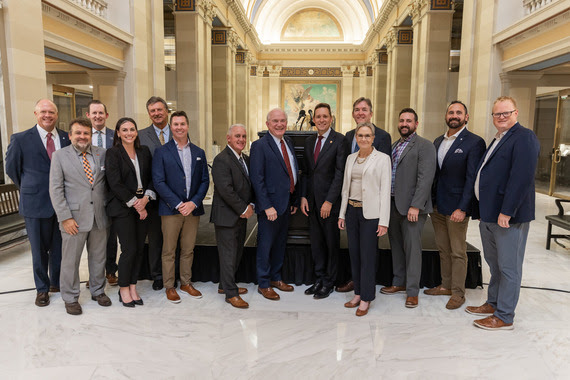The Oklahoma Department of Aerospace and Aeronautics (ODAA), in partnership with the Oklahoma Department of Transportation (ODOT), announced the launch of the Oklahoma Advanced Mobility Strategy in late September.
The announcement, held at the Oklahoma State Capitol, represents the culmination of an 18-month collaborative effort among public and private stakeholders to shape the future of mobility in Oklahoma through 2045.
Lt. Gov. Matt Pinnell underscored the importance of the strategy saying, “The Advanced Mobility Strategy represents Oklahoma’s commitment to not just participating in but pioneering the future of transportation. Our vision is to improve economic opportunity and quality of life for all Oklahomans. Through coordinated, proactive efforts, we will leverage advanced mobility technologies to improve safety, resilience, and economic growth.”
The groundbreaking initiative positions the state at the forefront of modern transportation technologies, from advanced air mobility (AAM) and unmanned aircraft systems (UAS) to autonomous vehicles (AV) and connected automated vehicles (CAV).
“ODOT is proud to be part of this effort, ensuring Oklahoma’s infrastructure supports cutting-edge advancements in both air and ground transportation,” said Tim Gatz, Executive Director of the Oklahoma Department of Transportation. “This strategy positions the state to be a national leader in the field, while maintaining our commitment to safe, efficient transportation for all Oklahomans.”
By laying out Oklahoma’s “Flight Plan” and “Road Map,” the strategy is designed to accelerate economic development, enhance safety, and improve access to next-generation mobility solutions for all Oklahomans.
Grayson Ardies, Executive Director of the Oklahoma Department of Aerospace and Aeronautics opened the event by emphasizing the importance of the collaborative effort behind the strategy. “This strategy is a culmination of the last 5 years as Oklahoma looked to transform our state’s advanced air mobility landscape and ensure we can be seen as the fly-to state for testing, development, and eventual manufacture of these emerging technologies. With input from diverse stakeholders across the state and industry, this effort sets a clear path forward for Oklahoma to lead in advanced air mobility, fostering technological innovation in aerospace and transportation.”
Oklahoma’s advanced mobility strategy positions the state to build an ecosystem with transportation options for goods and people, an expanded industry presence, and the creation of job opportunities to benefit all Oklahomans. Highlighting the potential of the industry, an economic impact analysis of UAS and AAM forecasts that by 2045 Oklahoma could accumulate:
- $8.9 billion in total economic benefit
- $5.5 billion in new business activity
- $455 million in local and state tax revenue
- 9,000+ new jobs
The strategy outlines several key goals:
- Vision: Improve economic opportunity and quality of life for all Oklahomans.
- Mission: Accelerate development, testing, and adoption of advanced mobility technologies through proactive, coordinated state-level guidance.
- Goal: Leverage advanced mobility technologies to improve efficiency, safety, resilience, access, and economic opportunity in Oklahoma.
For more information on the Oklahoma Advanced Mobility Strategy or to access the full report, visit these links:
Advanced Mobility Strategy Documents



